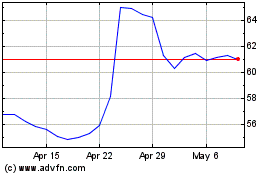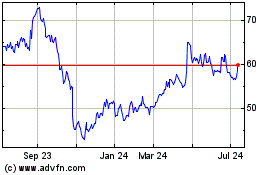By William Mauldin and Vivian Salama
WASHINGTON -- President Trump moved Thursday to extend tariffs
to essentially all Chinese imports, escalating a trade conflict
that is poised to hit U.S. consumers directly in the pocketbook and
roiling financial markets.
The new tariffs would take effect Sept. 1 and cover $300 billion
in Chinese goods -- including smartphones, apparel, toys and other
consumer products. They would come on top of tariffs already
imposed on $250 billion in imports from China.
"If they don't want to trade with us anymore, that would be fine
with me, " Mr. Trump said at the White House.
According to a person familiar with the situation, the tariff
hike was opposed by U.S. Trade Representative Robert Lighthizer,
Treasury Secretary Steven Mnuchin, White House economic adviser
Lawrence Kudlow and national security adviser John Bolton. But Mr.
Trump was adamant in pushing the increase and was supported by
White House adviser Peter Navarro, this person said. A spokesman
for Mr. Lighthizer said he "supports the president's action."
Wall Street was rattled by the news, with the Dow Jones
Industrial Average erasing a rebound of more than 300 points. The
index closed down 281 points, or 1.1% lower. The S&P 500 slid
0.9% and the technology-heavy Nasdaq Composite lost 0.8%. Oil
prices sank almost 8%, their biggest drop since February 2015.
The U.S. action could prompt fresh retaliatory measures from
Beijing, although there is also the possibility Mr. Trump could
withdraw his threat before the new levies go into force.
Mr. Trump made public his plans to impose tariffs in a series of
tweets that followed a briefing from his trade team on this week's
negotiations in Shanghai. Those talks ended with neither side
detailing significant progress toward resolving the more than
yearlong dispute.
Mr. Trump said that senior officials still planned to resume
high-level discussions as scheduled next month, and he expressed
his interest in reaching "a comprehensive Trade Deal" with
China.
But Mr. Trump chided President Xi Jinping of China for not
following through on what the Trump administration views as prior
commitments. "China agreed to...buy agricultural products from the
U.S. in large quantities, but did not do so," he wrote on Twitter.
"Additionally, my friend President Xi said that he would stop the
sale of Fentanyl to the United States -- this never happened, and
many Americans continue to die."
An official at the Chinese embassy in Washington didn't respond
to a request for comment.
The Wall Street Journal reported this week that the slow
progress in trade talks was partly the result of a new tactic from
Beijing, which increasingly thinks waiting may produce a more
favorable agreement.
In the U.S., business groups condemned the escalation of
tariffs.
"Tariffs are not the answer, escalation is not the answer," said
Myron Brilliant, head of international affairs at the U.S. Chamber
of Commerce in Washington. "We have to be careful about actions
undertaken by either government that would stir the pot and not
create the best atmosphere for getting these complicated talks back
on track."
The tariffs, essentially a tax paid by importers in the U.S.,
affect practically all the groups of Chinese products not hit
previously, with the exception of select categories, such as
medicines.
Unlike previous rounds of tariffs, which have focused largely on
industrial goods, the $300 billion tranche is set to include a host
of consumer products, from electronics and cellphones to
apparel.
The tariffs would affect about $45 billion in cellphones, $39
billion in laptops and tablets, and $5.4 billion in videogame
consoles, according to the Consumer Technology Association, a trade
group.
The tariff plans threaten to undermine U.S. sales of iPhone and
other Apple products, which are largely produced in China. Apple
would either have to eat the tariff costs on iPhones -- which
analysts have estimated would be about $40 on the import price of
XS models -- or pass those costs on to customers.
Apple's business in China also faces risks from potential
Chinese retaliation, trade experts and analysts said. The company,
which has relied on China, Hong Kong and Taiwan for about a fifth
of sales, would be a potential target for China because it had a
nearly 6% share of the Chinese smartphone market in the June
quarter.
Shares of Apple fell 2.1% Thursday, erasing a 2% surge on
Wednesday after the company reported it returned to sales growth in
the three month period ended June 29.
Dow Jones & Co., publisher of The Wall Street Journal, has a
commercial agreement to supply news through Apple services.
The toy industry, which sources about 85% of products from
China, has been bracing for the tariffs, including moving
manufacturing to places like Vietnam, Indonesia and Mexico and
importing the goods into the U.S. sooner.
Hasbro Inc. has notified retailers that it plans to raise prices
on any toys hit by tariffs and it also expects that retailers will
take ownership of inventory in the U.S. instead of China, which
will add to the toy maker's shipping and warehousing costs,
according to Chief Financial Officer Deborah Thomas.
Like Hasbro, Mattel, which makes Barbie dolls and Hot Wheels
cars, is looking to reduce its manufacturing footprint in China.
"We have put together a contingency plan and are working closer
with retailers to make sure we mitigate the impact," Mattel CEO
Ynon Kreiz said in an interview last month. "There are different
levers we can pull," he said, including using manufacturers and
vendors in other countries.
Toy makers may struggle to raise prices during the holiday
season because they have already set prices with retailers, said
Steve Pasierb, president of the Toy Association trade group,
meaning that the tariffs will hit the manufacturers' profits. A
larger concern is that as prices rise for other consumer goods hit
by tariffs, consumers may think twice about spending as much on
discretionary purchases like toys.
"It's a big concern because holiday spending power is important
as we finish the year," Mr. Pasierb said.
North Carolina entrepreneur Brett Portaro, who has developed a
line of Powercharger Corp.-brand cellphone-charging accessories,
said he was disappointed by the tariff news.
"For a new company like Powercharger, we can't adjust our supply
chain fast enough since almost all of the lithium-ion batteries
used in our products are made in China," he said.
The tariffs plan is the latest move by Mr. Trump to put pressure
on the Chinese side in hopes of winning concessions to help U.S.
businesses and farmers. Previous warnings of additional tariffs
have often been postponed, but three rounds eventually took effect.
Economists say the trade conflict is souring investment and hurting
economic growth in both countries.
Many Republican and Democratic lawmakers have backed Mr. Trump's
strategy of confronting Beijing as a necessary step to achieve
structural changes in the Chinese economy.
"Tariffs aren't the only solution President Trump should use to
pressure China, but China isn't making any friends in Congress with
its behavior, " wrote Sen. Chuck Grassley (R., Iowa), the chairman
of the Senate Finance Committee, in a tweet. "China has a
responsibility to follow through on its commitments on fentanyl +
ag purchases + trade talks."
About three-quarters of Republican voters support tariffs on
China without approval from the World Trade Organization, while
about three-quarters of Democrats oppose them, according to a June
survey from the University of Maryland.
One Democratic presidential candidate, Rep. Tulsi Gabbard of
Hawaii, said in the primary debate on Wednesday that she would
remove the tariffs if elected.
The latest round of tariffs, if imposed, is likely to generate
more complaints from consumers and voters. On the other hand, Mr.
Trump also faces potential criticism going into a presidential
election year if he compromises deeply and cuts a deal with China,
since Democrats and hawks in his own party have signaled they would
criticize any perceived shortcomings.
The Trump administration appears to be aiming to alleviate
consumer and business concerns by starting with tariffs of only
10%, a move that also allows U.S. officials room to raise the
tariff level in the future if China doesn't follow through with
concessions.
"The 10% is for a short-term period and then I could always do
much more or less, depending on what happens with respect to a
deal," Mr. Trump said.
Meanwhile, U.S. farmers are increasingly suffering from
retaliation from China and other countries where the Trump
administration has penalized trade. Farm products are also facing a
disadvantage in Japan, which has opened its markets to other
countries through the Trans-Pacific Partnership, a deal Mr. Trump
withdrew from.
After meeting Mr. Xi in Osaka, Japan, in June, Mr. Trump and
administration officials said they had won commitments from Beijing
to purchase more U.S. agricultural products. The administration is
also seeking a quick trade agreement with Japan focused on
agriculture.
But Beijing hasn't said that it committed to the purchases, and
Chinese firms have made only limited purchases of agricultural
commodities in recent weeks.
The U.S. team in Shanghai this week, led by Mr. Lighthizer and
Mr. Mnuchin, was hoping the Chinese side would commit to purchasing
a defined quantity of U.S. agricultural goods, people following the
talks said.
China is likely holding out on buying large amounts of U.S. farm
goods while waiting for concessions from the U.S. side, the people
said.
Mr. Trump has said his administration would take a softer
approach on Chinese telecommunications giant Huawei Technologies
Co., allowing firms to do business with the blacklisted company if
it doesn't trigger security concerns.
So far the Trump administration hasn't formalized licenses for
U.S. firms to sell semiconductor chips and other products to
Huawei. Administration officials are looking at a plan that would
allow chip companies to sell to Huawei consumer products, such as
cellphones, but not sell advanced chips to the company's
telecommunications infrastructure, which many U.S. officials view
as a national-security threat.
--Katy Stech Ferek and Andrew Restuccia in Washington, Tripp
Mickle in San Francisco and Paul Ziobro in New York contributed to
this article.
Write to William Mauldin at william.mauldin@wsj.com and Vivian
Salama at vivian.salama@wsj.com
(END) Dow Jones Newswires
August 01, 2019 19:39 ET (23:39 GMT)
Copyright (c) 2019 Dow Jones & Company, Inc.
Hasbro (NASDAQ:HAS)
Historical Stock Chart
From Mar 2024 to Apr 2024

Hasbro (NASDAQ:HAS)
Historical Stock Chart
From Apr 2023 to Apr 2024
